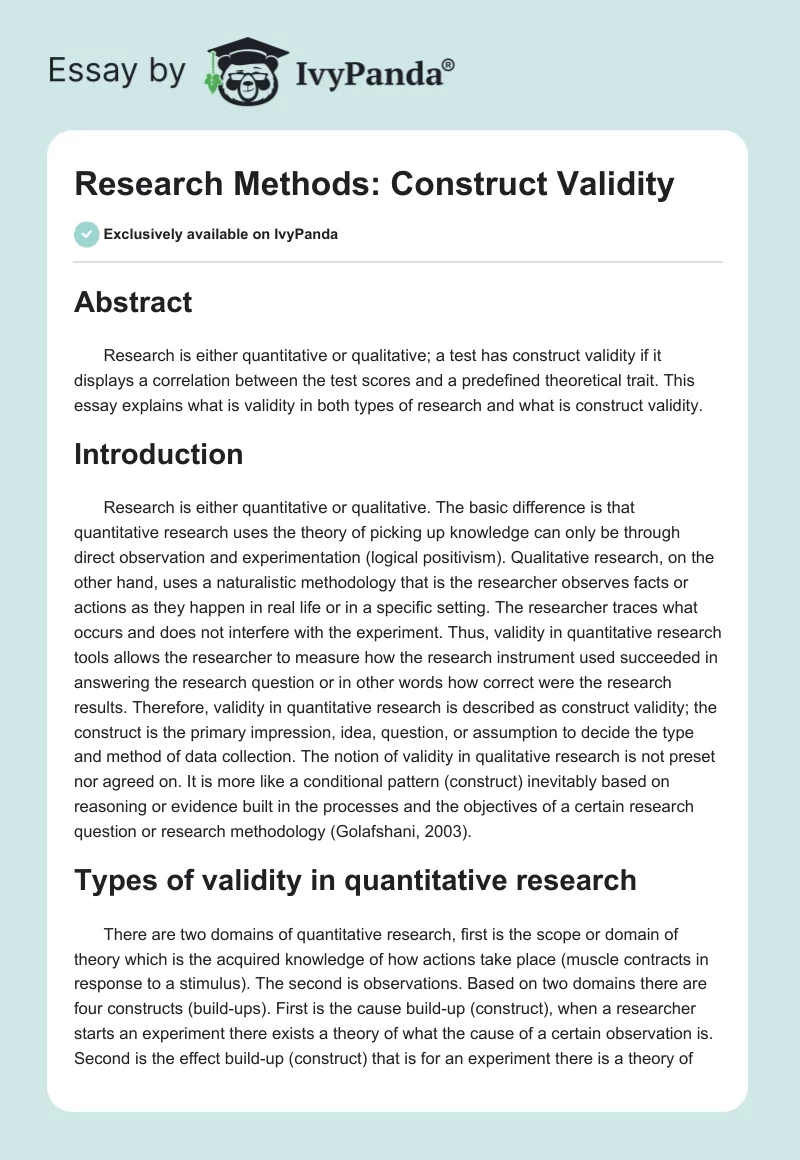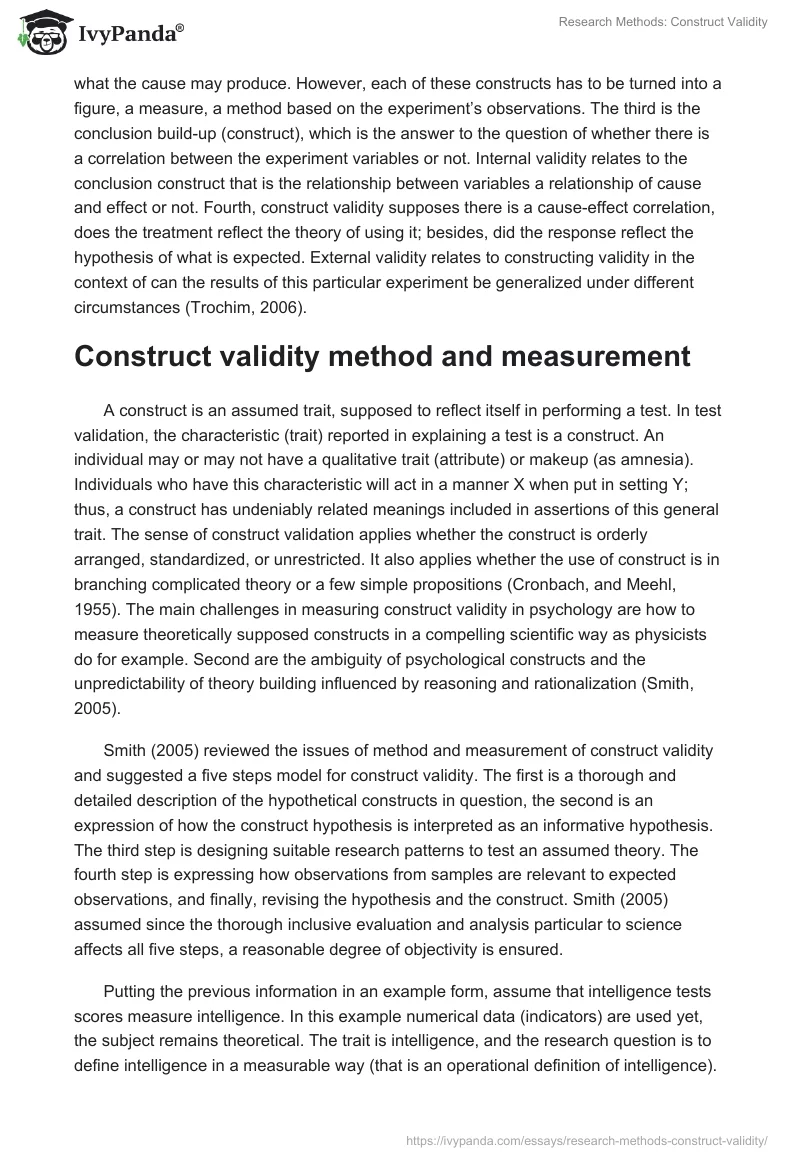Abstract
Research is either quantitative or qualitative; a test has construct validity if it displays a correlation between the test scores and a predefined theoretical trait. This essay explains what is validity in both types of research and what is construct validity.
Introduction
Research is either quantitative or qualitative. The basic difference is that quantitative research uses the theory of picking up knowledge can only be through direct observation and experimentation (logical positivism). Qualitative research, on the other hand, uses a naturalistic methodology that is the researcher observes facts or actions as they happen in real life or in a specific setting. The researcher traces what occurs and does not interfere with the experiment. Thus, validity in quantitative research tools allows the researcher to measure how the research instrument used succeeded in answering the research question or in other words how correct were the research results. Therefore, validity in quantitative research is described as construct validity; the construct is the primary impression, idea, question, or assumption to decide the type and method of data collection. The notion of validity in qualitative research is not preset nor agreed on. It is more like a conditional pattern (construct) inevitably based on reasoning or evidence built in the processes and the objectives of a certain research question or research methodology (Golafshani, 2003).
Types of validity in quantitative research
There are two domains of quantitative research, first is the scope or domain of theory which is the acquired knowledge of how actions take place (muscle contracts in response to a stimulus). The second is observations. Based on two domains there are four constructs (build-ups). First is the cause build-up (construct), when a researcher starts an experiment there exists a theory of what the cause of a certain observation is. Second is the effect build-up (construct) that is for an experiment there is a theory of what the cause may produce. However, each of these constructs has to be turned into a figure, a measure, a method based on the experiment’s observations. The third is the conclusion build-up (construct), which is the answer to the question of whether there is a correlation between the experiment variables or not. Internal validity relates to the conclusion construct that is the relationship between variables a relationship of cause and effect or not. Fourth, construct validity supposes there is a cause-effect correlation, does the treatment reflect the theory of using it; besides, did the response reflect the hypothesis of what is expected. External validity relates to constructing validity in the context of can the results of this particular experiment be generalized under different circumstances (Trochim, 2006).
Construct validity method and measurement
A construct is an assumed trait, supposed to reflect itself in performing a test. In test validation, the characteristic (trait) reported in explaining a test is a construct. An individual may or may not have a qualitative trait (attribute) or makeup (as amnesia). Individuals who have this characteristic will act in a manner X when put in setting Y; thus, a construct has undeniably related meanings included in assertions of this general trait. The sense of construct validation applies whether the construct is orderly arranged, standardized, or unrestricted. It also applies whether the use of construct is in branching complicated theory or a few simple propositions (Cronbach, and Meehl, 1955). The main challenges in measuring construct validity in psychology are how to measure theoretically supposed constructs in a compelling scientific way as physicists do for example. Second are the ambiguity of psychological constructs and the unpredictability of theory building influenced by reasoning and rationalization (Smith, 2005).
Smith (2005) reviewed the issues of method and measurement of construct validity and suggested a five steps model for construct validity. The first is a thorough and detailed description of the hypothetical constructs in question, the second is an expression of how the construct hypothesis is interpreted as an informative hypothesis. The third step is designing suitable research patterns to test an assumed theory. The fourth step is expressing how observations from samples are relevant to expected observations, and finally, revising the hypothesis and the construct. Smith (2005) assumed since the thorough inclusive evaluation and analysis particular to science affects all five steps, a reasonable degree of objectivity is ensured.
Putting the previous information in an example form, assume that intelligence tests scores measure intelligence. In this example numerical data (indicators) are used yet, the subject remains theoretical. The trait is intelligence, and the research question is to define intelligence in a measurable way (that is an operational definition of intelligence). The data used in verifying the research hypothesis (indicators) and the performance on the intelligence test provides the operational definition. This example does not have construct validity since intelligence tests display specific types of intelligence, and they are argued to measure cultural experiences more than intelligence (American University Library, 2007)
Conclusion
A construct is an assumed trait (as intelligence) supposed to reflect itself in performing a test. A test has construct validity if it displays a correlation between the test scores and the prediction of a theoretical trait.
References
American University Library (2007). Construct Validity. Web.
Cronbach, L. J., and Meehl, P. E. (1955). Construct Validity in Psychological Tests. Psychological Bulletin, 52, 281-302.
Golafshani, N. (2003). Understanding Reliability and Validity in Qualitative Research. The Qualitative Report, 8 (4), 597-607.
Smith, G. T. (2005). On Construct Validity: Issues of Method and Measurement. Psychological assessment, 17 (4), 396-408.
Trochim, W. M. K. (2006). Introduction to Validity.


